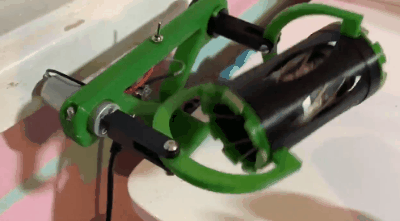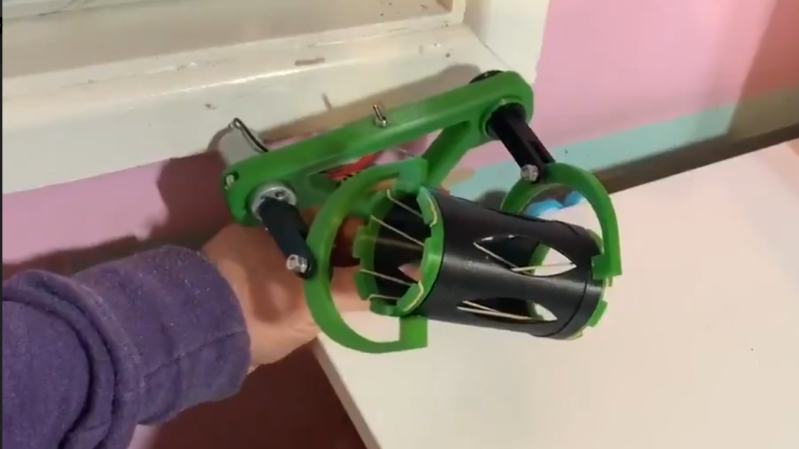To get the perfect mix for your paint, you need a good shake that is as random as possible. [Mark Rhodes] wanted to automate the process of mixing paint, so he built a 3D printed shaker to thoroughly shake small paint bottles. Using only a single motor, it shakes the bottle along three axes of rotation and one axis of translation.
A cylindrical container is attached to a U-shaped bracket on each end, which in turn is attached to a rotating shaft. Only one of these shafts are powered, the other is effectively an idler. When turned on, it rotates the cylinder partially around the pitch and yaw axis, 360 degrees around the roll axis, and reciprocates it back and forth. The design appears to be based on an industrial mixer known as a “Turbula“. Another interesting feature is how it holds the paint bottle in the cylinder. Several bands are stretched along the inside of the cylinder, and by rotating one of the rings at the end, it creates an hourglass-shaped web that can tightly hold the paint bottle.
The mechanism is mounted on a 3d printed frame that can be quickly clamped to a table. The Twitter post embedded below is a preview for a video [Mark] is working for his Youtube channel, along with which he will also release the 3D files.
Mixing machines come in all shapes and sizes, and we’ve seen a number of 3D printed versions, including a static mixer and a magnetic stirrer.
So I have been working on a little something to help me mix my paints. It is completely and utterly over engineered for the problem, and that is why it reminds me of the bottle opener that @donttrythis and @Laura_kampf made 🤣. It does look cool though! pic.twitter.com/2EatMGfC5j
— Mark Rhodes (@mrhodes) August 25, 2020
















“To get the perfect mix for your paint, you need a good shake that is as random as possible.” or something really well organized that mixes it half and half 16 times (for a paint can 20cm tall – add one more shake every time you double the size). Declaring something perfect is begging for a comment!
That motor shaft bearing/sleave realy like those moments. Great design.
It looks impressive and mesmerizing, but I had some doubts whether this was complete overkill or not.
Still had a look at the “Turbula” for comparison.
The Turbula is designed for mixing solids. (powders) which is a whole lot more difficult then liquids and then it makes a lot more sense.
Solids can have a strong tendency to un- mix themselves when shaken (or stirred).
Big particles come floating on top, because small particles fall in the holes left by bigger particles.
Wow, so many possibilities!
:o)
This looks ideal for spray paint tins with the ball bearing mixer. I get fed-up and a sore elbow within about 30 seconds of shaking these spray cans.
Do not insert penis.
I wonder if the same concept could be used for a Ball Mill. Would the motion work well for grinding powders? It would need to be beefed up to handle the weight and associated stresses but the form is pretty good for the application.
With this i will absolutely win the step challenge at work!
Enjoy walking … like a fool!!!
https://www.youtube.com/watch?v=YGcfqvIt6iw
Hey there,
what a Great Mixer. Is there a Version for a spray paint can with Ball availible?
It would be Great because I Head to Shake so many cans in the last time.
Hope for an answer
Best regards